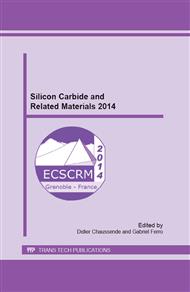p.460
p.464
p.468
p.472
p.476
p.480
p.484
p.488
p.492
Influence of Annealing, Oxidation and Doping on Conduction-Band near Interface Traps in 4H-SiC Characterized by Low Temperature Conductance Measurements
Abstract:
Current power MOSFET devices on Silicon Carbide show a limited inversion channel mobility, which can be a result of the expected very high density of interface states near the conduction band . In the current work, the effect of the post implantation annealing temperature, the thermal oxidation and the nitrogen doping of the n-epi layer on the density of these interface traps is investigated using capacity-conductance measurements. Instead of the usage of very high frequencies as used in , in this investigation the measurements were performed in liquid nitrogen to decrease the recharging times of the interface traps.Due to the different processing the samples showed a wide spreading of the inversion channel mobility. The conductance measurements show a characteristic peak caused by the conduction band near interface traps especially for the low temperature measurements. But these traps could not be correlated to the mobility. Instead, a correlation to the nitrogen doping of the epi layer could be observed.
Info:
Periodical:
Pages:
476-479
Citation:
Online since:
June 2015
Authors:
Keywords:
Price:
Сopyright:
© 2015 Trans Tech Publications Ltd. All Rights Reserved
Share:
Citation:


